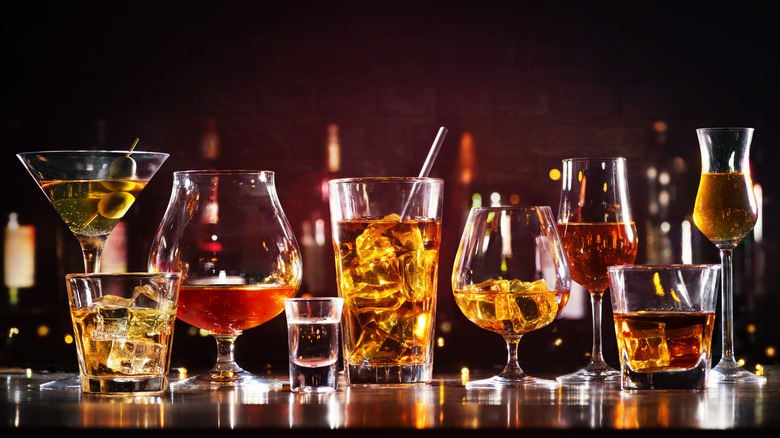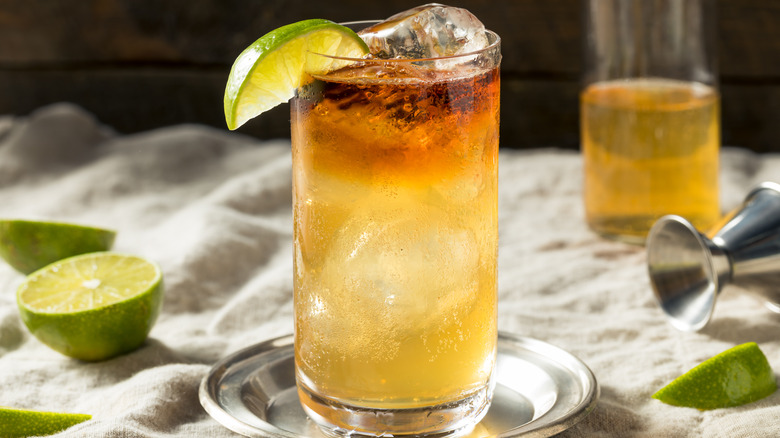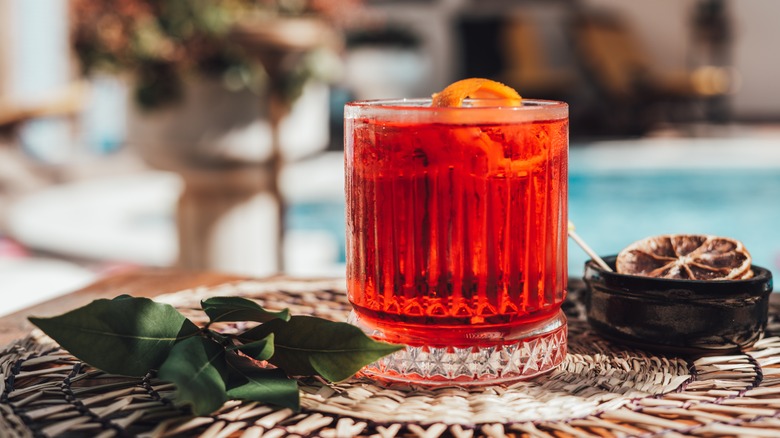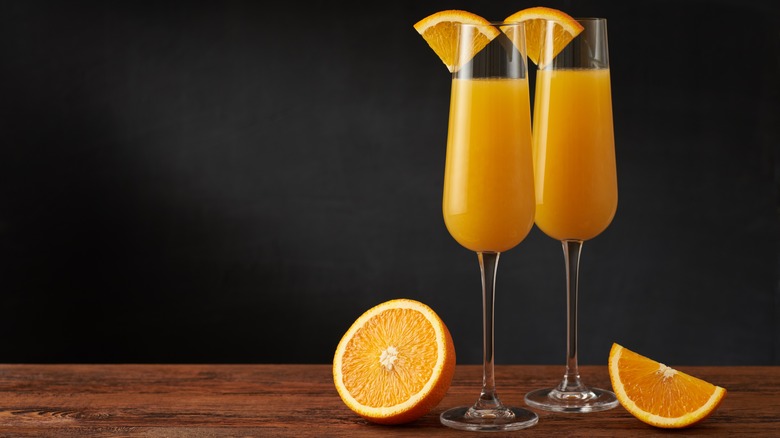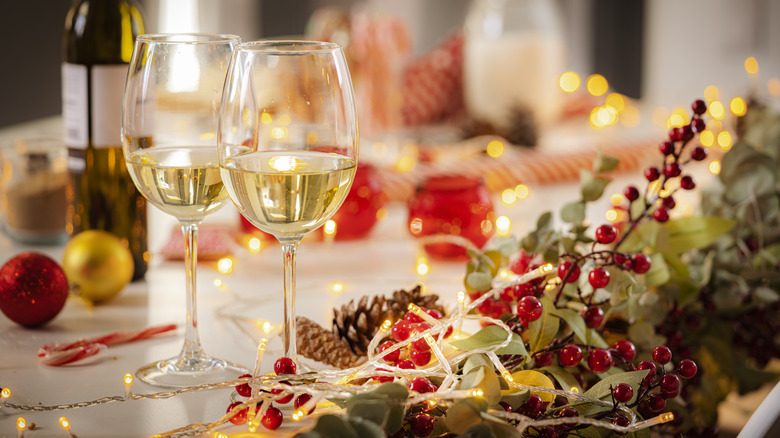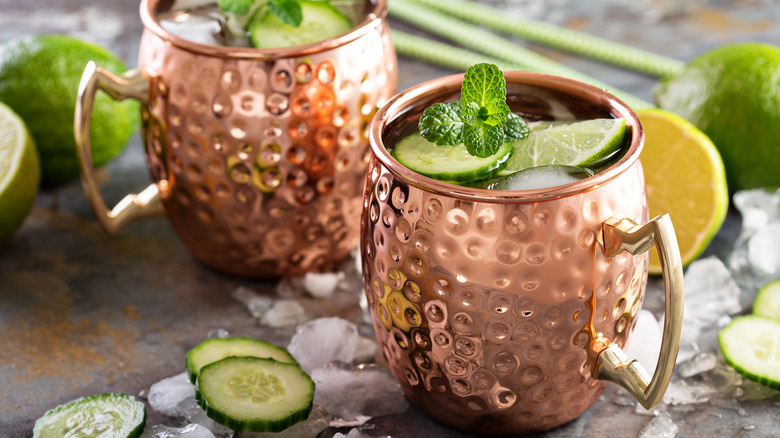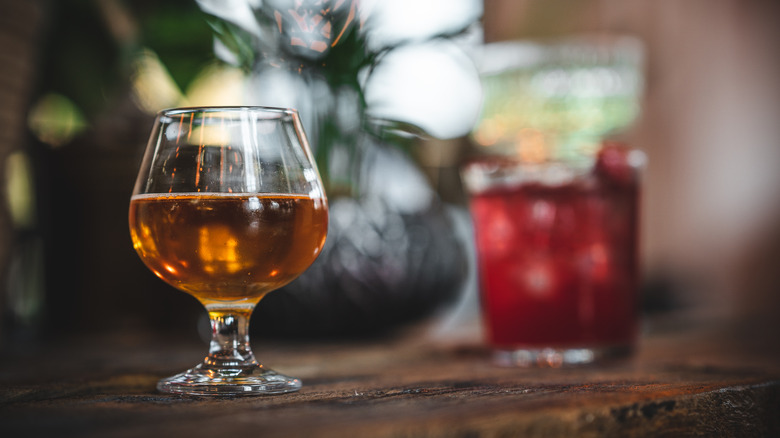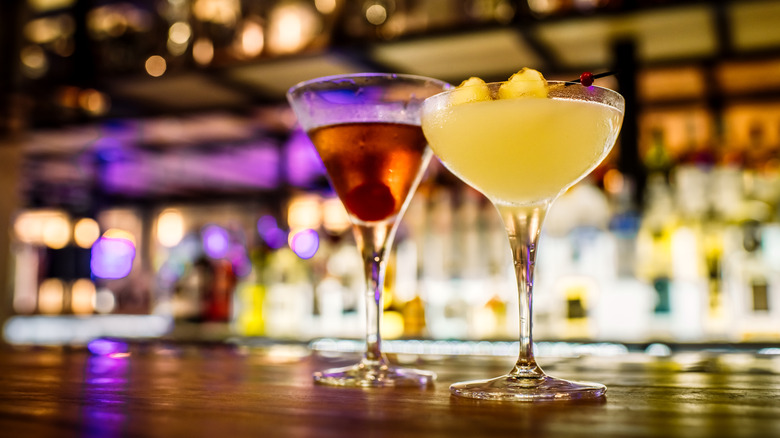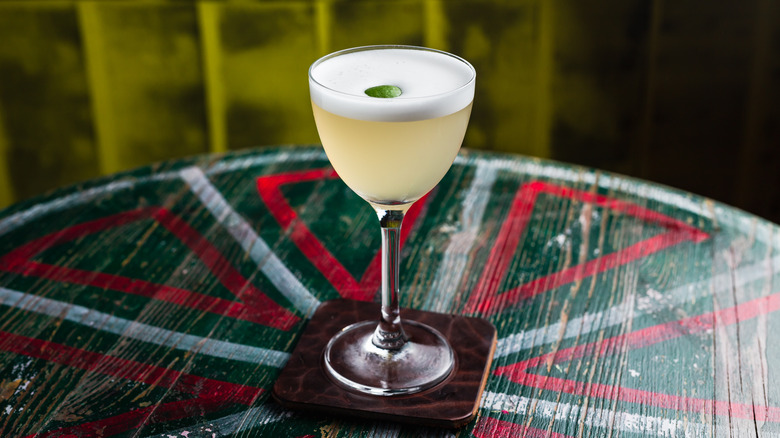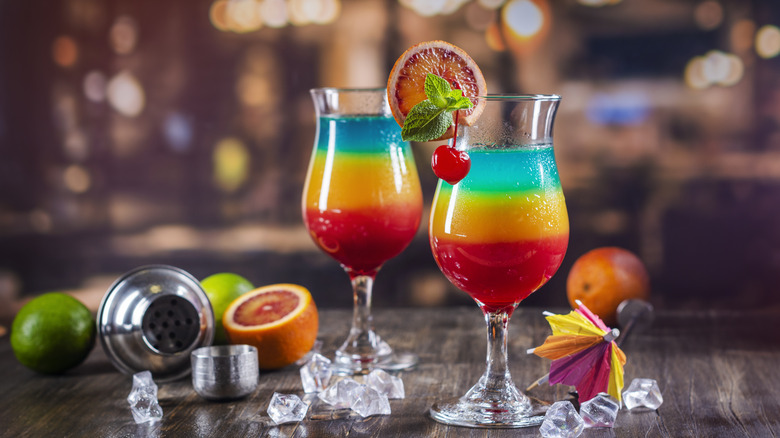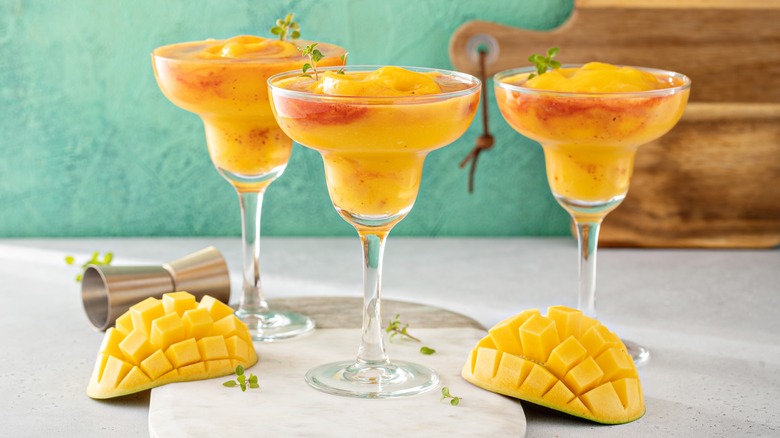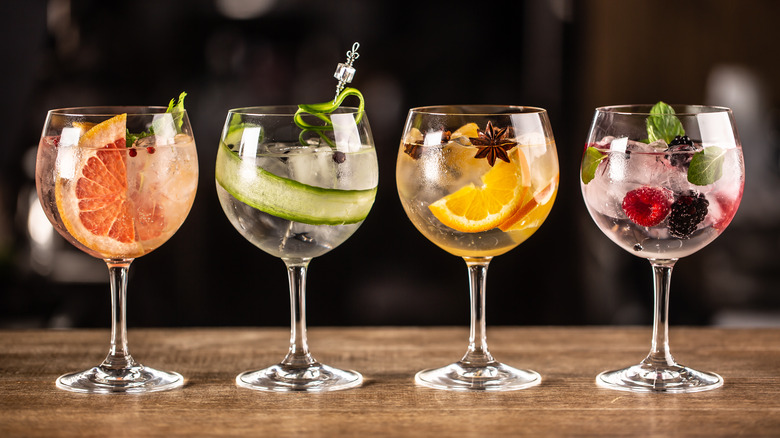11 Cocktail Glasses And What They Should Be Used For, According To An Expert Beverage Director
Choosing the right glass for your cocktail isn't just about aesthetics — it can also enhance the flavors and aromas in the drink. To learn more about how glassware overlaps with mixology, we've spoken to Flemming Love, Beverage Director at Michelin-recommended restaurant the Southern Belle & Georgia Boy. Love notes that choosing the perfect cocktail glass "is crucial to maintaining the proper amount of dilution in each drink as well as executing the presentation desired."
The way you hold your drink also affects its temperature and the rate at which any added ice melts, making it super important for bar staff to pick the right container. Love observes that "each type of ice interacts with each glass differently and having a stem on a glass keeps it colder as well."
Along with these considerations, there's also a surprising amount of glassware to choose from when mixing cocktails behind a bar. To get the insider lowdown on which glasses complement which drinks, we asked Love about some of her go-to favorites.
1. Highball/ Collins
Highball glasses are tall and thin and can usually hold around 8-12 fluid ounces. Flemming Love explains that their height makes highballs "ideal for drinks that are on ice — regular rocks or pebbles." and "when there is a higher ratio of mixer to spirit" in a drink. Highball glasses don't have a stem, meaning that you naturally warm them with your hands when you hold them. Cocktails in which the alcohol is meant to be quite diluted don't suffer from this slight temperature rise as the ice and mixers are factored into the flavor.
Dark 'n' Stormy cocktails — which mix dark rum, ginger beer, and lime juice with a dash of bitters and simple syrup – are perfect in highballs. The rum is meant to interact with the other ingredients, rather than being the primary flavor. A Bloody Mary containing tomato juice, vodka, and bitters can also be served in a highball.
Highballs aren't the only tall glasses you'll find behind a bar and are often confused with their longer, slimmer cousins, the Collins glass. These glasses are narrower than highballs and can hold 10-14 fluid ounces. Taking its name from the Tom Collins cocktail – a zesty mix of gin, sugar syrup, lemon juice, and soda water – Collins glasses look great when filled with bubbles. "I personally love putting fizz drinks in Collins glasses," Love states — "you have plenty of room for the delicious foam!"
2. Lowball/ Rocks
Lowball or rocks glasses are squat and wide and are used to serve drinks that contain large ice cubes or "rocks." Flemming Love explains that "this type of ice doesn't melt as fast, but keeps your drink chilled." This makes rocks glasses "perfect for sipping drinks that are spirit forward and flavor-packed," Love says, naming Old Fashioned cocktails and Negronis as some of her favorite examples. Lowball glasses also generally have a thicker base than highballs and can hold about 6-8 fluid ounces in a single glass, or around 12-14 fluid ounces in a double.
Love also notes that the wide-brimmed shape of lowball glasses is also important as it "allows the aromas to breathe." This is great for fragrant cocktails, like a Negroni, which uses a blend of aromatic herbal liqueurs — specifically vermouth and Campari — to create a deliciously bittersweet gin-based drink. Meanwhile, the wide, sturdy base on lowball glasses means that bartenders can muddle ingredients inside the glass. This is standard when making an Old Fashioned, which contains a blend of whisky, sugar, soda water, bitters, and orange slices, and is usually mixed and served in a lowball tumbler.
3. Flute
It's impossible to think of the thin-stemmed flute glass without picturing luscious prosecco bubbles or overflowing champagne. However, flute glasses are also a brilliant option for many cocktails and can hold about 6 fluid ounces. Flemming Love notes that they "enjoy putting all cocktails that are topped with bubbles into flutes. They look beautiful and give enough space for the topper to fill the glass."
The stems on flutes prevent you from touching the bulb, maintaining the drink's cool temperature for longer. This makes flutes ideal for serving chilled drinks off the rocks. The flute's tall, narrow shape also reduces air escaping from the top, meaning your fizz stays fizzy for longer.
"French 75's and Mimosas are my favorite of the classic cocktails to put in a flute," Love says. The gin and champagne-based French 75 — that officially entered the classic cocktail canon in 1930 with its inclusion in Harry Craddock's "Savoy Cocktail Book" — looks beautiful served in a tall flute with a winding lemon peel twist. Meanwhile, Mimosas are a fruity brunch classic made with fresh orange juice, champagne or prosecco, and an optional shot of Grand Marnier.
4. Wine Glass
Stemmed wine glasses are, of course, primarily used for serving red or white wine. A standard white wine glass holds roughly 12 fluid ounces, while slightly larger red wine glasses typically clock in at around 12-16 fluid ounces. Flemming Love observes that "there are a couple of classic cocktails that I think look gorgeous in a wine glass" as the "volume of liquid able to be held [...] allows space for more garnishes inside of the drink."
When asked which cocktails these are, Love told us that "Sangria and Aperol Spritz are at the top of the list." Both of these cocktails have a bright, appealing color, that looks great in a clear glass, and contain fruit slices as garnishes. They also generally have a "low abv", something that Love favors when serving cocktails in a wine glass. This is because customers will usually expect a larger pour with a lower-alcohol drink or may even buy a jug — as is often the case with sangria — and refill their glasses at the table.
5. Chiller Mug
Chiller mugs are great for fun, novelty cocktails that carry a lot of garnishes or for tropical cocktails that you want to drink icy cold. Unlike traditional glassware, Flemming Love explains that chiller mugs "are made out of metal, typically either copper or stainless steel," and "are ideal for drinks served on pebbles ice." The metal mug helps keep the liquid cool while the ice pebbles melt, giving you a drink that you can sip on for longer. "I love using these for tiki drinks that have a lot of components and garnishes to them," Love continues, with some of her favorites including Mint Juleps and Moscow Mules.
Chiller mugs vary in size, with many holding between 16-18 fluid ounces. This makes them great for long, heavily diluted cocktails. They also usually have a mug handle that prevents your hands from warming up the metal sides.
Copper also carries certain flavors well. The zesty ginger beer and lime combo in a Moscow Mule will shine in a copper mug, while the frosty chill helps neutralize the underlying spirit taste from the vodka. Mint juleps, meanwhile, were originally served in silver tumblers at the Kentucky Derby races during the 1800s and have been traditionally poured out in metal ever since. They also just happen to look extra refreshing in copper with a heap of crushed ice and a hefty sprig of fresh mint for a garnish.
6. Snifter
True to its name, the snifter glass was designed for drinking strong, aromatic liquors, such as cognac, whisky, and bourbon. These short glasses have a wide, rounded base and narrow towards the top. This allows the scents to concentrate better in the glass and channels them towards your nose while you drink. Flemming Love explains that this also affects how you experience the drink's taste.
According to Love, snifters "allow the aromas to breathe and affect the palette differently because of how much of the aroma reaches your senses before it ever reaches your mouth." This makes them ideal "for top shelf and high-quality liquors and spirits" which have complex flavor profiles and are designed to be savored. The rounded base encourages you to swirl the liquid before drinking and allows your drink to warm up naturally as you hold the glass, both of which further enhance the aromas. Typically, a snifter glass for spirits will hold around 6-8 fluid ounces, although larger snifters are also used for some high-quality beers.
7. Coupe/ Martini
Coupe glasses and martini glasses look effortlessly sophisticated and always bring to mind classic cocktails. While coupes (pronounced KOOP) have a wide, rounded base and were the original French champagne glasses back in the 1700s, martini glasses have a deep, conical bowl and are famously used for serving martinis. Flemming Love clarifies that "these glasses are used for all drinks served 'up' instead of on ice." They are also "used for either stirred or shaken cocktails," which are prepared separately and then poured into a chilled glass rather than being built or muddled in a rocks glass.
Love also notes that coupe and martini glasses "are also lovely for presentation when you have a beautiful liquid inside. They don't hide the color or clarity of your cocktail." Think a cold, clear gin martini with olives in a classic Martini glass or a devilish red Manhattan – rye, sweet vermouth, and Angostura bitters stirred with ice and then strained — in an elegantly rounded coupe. According to Love, coupe glasses usually hold around 6-8 fluid ounces, making them versatile for serving a range of drinks, while a martini glass can hold around 8 fluid ounces.
8. Nick and Nora
The Nick and Nora cocktail glass has a fascinating history in the bartending world and looks unbeatably polished with a chilled, clear cocktail served straight up. Nick and Noras have a thin stem and a dainty, rounded bulb. "The Nick and Nora glass was coined by Dale DeGroff in 1987 in NYC," Flemming Love explains. "He is credited as being one of the fathers of the modern contemporary cocktail movement."
DeGroff, who was famously known as King Cocktail in the New York Bar scene, named the Nick and Nora glass after a pair of fictional sleuths, Nick and Nora — a crime-solving married couple from Dashiell Hammet's 1934 novel, "The Thin Man." This novel was adapted into a film in 1939 and, in the film, Nick and Nora are portrayed drinking cocktails from these delicate stemmed glasses. Breaking with the 1980s trend for pouring huge, spirit-heavy cocktails into large glasses, DeGroff named and revived the Nick and Nora glass to serve more discreet measures.
The trend caught on and Nick and Noras are still popular today. Love observes that the appeal of the Nick and Nora glass isn't just about aesthetics, it's the ideal size for spirit-forward cocktails that don't require much dilution. The bulb holds about 5-6 fluid ounces allowing you to enjoy a strong drink, but not too big and overpowering, and is small enough to stay cold while you finish it.
9. Hurricane glass
Hurricane glasses are tall and wide and usually have a short stem and a rounded base. They narrow slightly towards the middle like a snifter and then flare out again at the top. When these arrive at your table, you know you're in for a good time — as Flemming Love notes, the hurricane glass's "biggest use is for drinks with a lot of volume i.e. Pina colada and other frozen or tropical drinks." They can hold anything from 9 to 20 fluid ounces and are often served in hot-weather vacation destinations.
Similar to chiller mugs, hurricane glasses are good for cocktails served over crushed iced or pebbles. They are also usually associated with punchier, alcohol-heavy drinks so that the added volume doesn't water down the cocktail too much. For example, a hurricane cocktail — named after the glass, which was given its name because the shape reminded people of a hurricane lamp – can contain up to 4 fluid ounces of rum. It was invented in the New Orleans French Quarter during the 1940s and is a famous party cocktail in the city.
10. Margarita glass
The margarita glass is similar to a coupe but it usually has a slightly dipped base beneath a shallower, more expansive brim. Flemming Love notes that "this glass' primary appeal is its aesthetics." Due to its long stem that prevents you from holding the glass bulb, Love explains that "it is arguably just as effective as a coupe for keeping a drink cold," meaning that they're interchangeable in terms of function. Margarita glasses have a slightly larger volume than a coupe, typically holding around 9 fluid ounces.
Margarita glasses are particularly associated with margarita cocktails, especially frozen margaritas. These sweet and sour cocktails were invented in Mexico — although there are several origin stories — with the first known mention coming in a Santa Rosa, California newspaper called "The Press Democrat" in September 1953. It traditionally contains a mixture of tequila, triple sec, and lime juice. You'll often find a ring of salt around the brim of your margarita glass — the wide shape works well for this and looks impressive with a lime slice.
The wide-based margarita glass is also handy for containing the slushed ice in a frozen margarita. The slight dip in the bulb lets the volume collect more in the base and means you are less likely to spill freezing liquor on yourself. Many bartenders prefer to serve frozen daiquiris or fruit-flavored margaritas in a clear margarita glass, rather than a copper mug, to show off the vibrant colors in the drink.
11. Gin Balloon
Like snifters and Nick and Noras, gin balloon glasses work to enhance the fragrances in your drink. As Flemming Love explains, it "serves a similar purpose with the shape of a wine glass because it focuses on the 'nose' and aromatics of the spirit." Gin balloons have a wide, rounded base that lets the gin botanicals breathe, while the slightly narrowed top filters aromas toward your palette. The deep bulb also has room for ice and garnishes, while the stem is important for cold drinks like a classic gin and tonic.
Gin balloons can range in size, with smaller sizes at around 10 fluid ounces to much larger glasses that hold around 27 fluid ounces. The bowl-like glass shape looks particularly good with a muddle of clear liquid, large ice cubes, lime wedges or cucumber slices, and sprigs of fresh mint inside. These aesthetic glasses will also complement gin drinks that have a bit of color like a pink gin and tonic or one with a splash of sweet Campari added.
Methodology
To write this article, we drew from Flemming Love's expert advice on glassware and mixology. Their opinions on which glass to use for particular cocktails were sent exclusively to Foodie.
We also conducted research into cocktail recipes and glassware. This was done by reading online drinks blogs, and publications and drawing upon the experience of five years working behind a bar.
